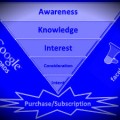Retargeting (aka remarketing): Some of us may have heard the term or even used it. Few know how to define it. Almost anyone who has been on the web however knows what it is. It’s that strange feeling someone has been looking over your shoulder while you were browsing. That someone knows what products were on the pages you visited and is now serving you tons of advertisements of those very same products on almost every damn web page you land on. It may be creepy but if done right, it could also get you an extra discount on that book you wanted to buy or simply remind you to download that white paper you wanted the other day.
There are various types of retargeting such as search, email, SEO, contextual, engagement and site retargeting. In this post I will focus on the most common type of retargeting which is site retargeting.
How does retargeting work?
Retargeting is the act of displaying a web advertisement to a specific user based on web pages that he or she previously viewed on your web site (or on other sites). It requires the advertiser to put a snippet of code (a pixel) on his web page which will in turn create a cookie in the web user’s computer or mobile device when they visit the page in question. The cookie enables the advertiser to capture identifying information on that specific user. When a cookie-enabled user visits a web page which offers advertisement real estate, he or she will be recognised as a former visitor of the advertiser and be served an ad that pertains to products or information viewed previously.
When to use retargeting?
Web retargeting is a very efficient tool to increase conversion rates. A conversion being the result of a series of actions a visitor undertakes on a web site. On an e-commerce site a conversion could be the act of purchasing a product. On non commercial sites a conversion could be signing up to a newsletter, making a donation, downloading a white paper or leaving a review.
Hence, anytime you measure event conversions and want to increase them, retargeting is a great tool. Of course, a bit of judgement is in order here. If you manage an erotic online business, alcohol addiction rehab facility or STD clinic you may, for the sake of your visitors and future visits, want to refrain from using retargeting.
How effective is retargeting?
Although I couldn’t find hard data on the effectiveness of retargeting some advertising agencies cite ROI of anywhere from 2$ to 10$ on every dollar invested in retargeting advertisements. Customers and entrepreneurs who I asked, which do not represent a statistically significant sample, report conversation rate increases of 10 to 30 percent. The data would seem to suggest that remarketing is a profitable marketing tactic.
It is important to note however that measuring the effectiveness of a retargeting campaign is not straightforward. Usually other marketing or web development activities will take place simultaneously and impact the conversion rate numbers. The best way to measure is to try and isolate via A/B testing the impacts of retargeting.
Retargeting best practices
- Retargeting is very much a numbers game. Because the click through rate (CTR) on ads is very low (usually less than 5%) you need high number of tagged visitors to see any results. Hence if you only have a few dozen visitors daily on your site, this tactic will not be profitable for you.
- Like any other tool, when used on a standalone basis without a marketing strategy to support it, remarketing looses much of its effectiveness.
- Proper pixel placement on your various web pages to segment your visitors is also essential. Usually placing your pixel on pages that are at the end of your funnel will enable you to track non-converting visitors.
- Limiting the number of ads a non converting visitor will see in a specific time period (with caps) will help prevent negative feeling buildup against your brand or product.
- Finally, using burn pixels (a code that identifies when a visitor has converted) will avoid you paying for ads being displayed to visitors who have already bought your products or converted in other ways.
There are many other best practices that vary according to your initial strategy. Most web marketing platforms, accessible cost-wise to small businesses, that offer retargeting (such as Google, Bing, Facebook, Twitter, etc.) have built in best practices. If you are unsure of how to go about your first retargeting campaign or do not have the skill set internally, digital marketing agencies can be of help.
Why is it so creepy?
Many web users dislike seeing retargeted ads. Aside from just disliking ads, it’s also a question of not being use to it. Retargeting is relatively new. Web users are just getting acquainted with the practice. Once they get more familiar with how it’s done and the mechanics of it, they will certainly feel less creeped out. Advertisers who don’t follow best practices and bombard users with ads or even worse with ads of products that have already been purchased are also to blame here.
Retargeting is a component of one to one digital marketing that is still in its infancy. The more precise and refined data collection gets the more useful retargeted ads will be to users. Imagine a world where the only ads you will ever see will be for products or services you are thinking of purchasing or need to purchase, from the businesses you can actually buy them from and at the best possible price.










